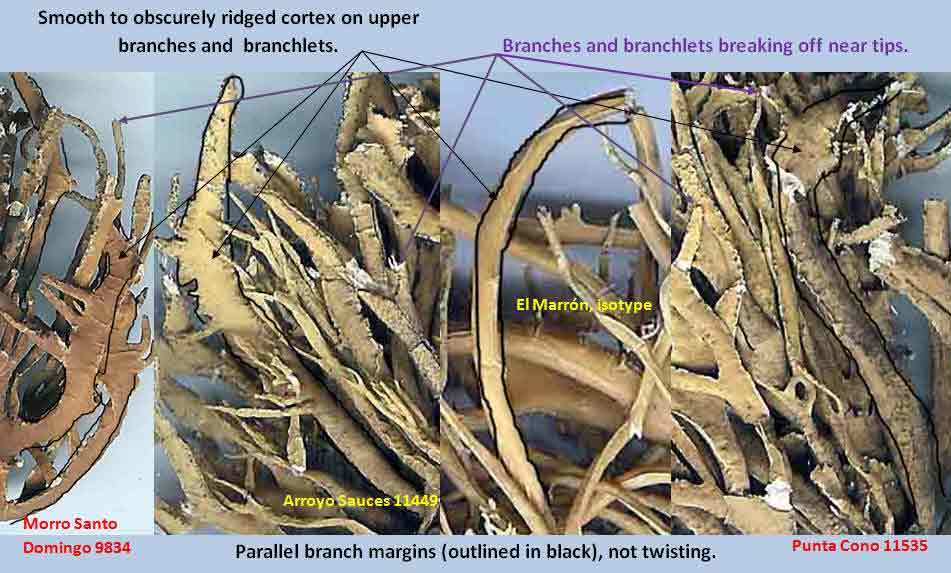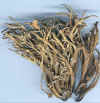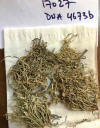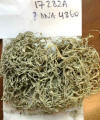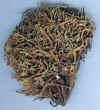Niebla juncosa
is a species of fruticose lichen endemic to Baja California, ranging from the southern part of the Northern
Vizcaíno Desert at Morro Santo Domingo north to Punta Banda in the Coastal Sage Chaparral region.
It occurs on rocks along ridges and on sand under bushes near sea level.
It is recognized by its bushy growth
and by the basal branches that are long linear-like with sharply defined
margins that become densely lined with pycnidia in upper third, and with
relatively smooth inter-marginal cortex. The primary branches often expand
near apex appearing with shorter secondary secund or pectinately arranged short
branches of ± same width.
Two varieties are recognized by the regular and irregular orientation of
branches and branchlets; the typical variety has branches oriented mostly in the
same direction, usually erect to falcate secund (curved in same direction), in contrast to interwoven branches of var. spinulifera. Also,
the branch margins scarcely alternate or twist in var. juncosa, and the
branches break off near apices. In contrast, var. spinulifera has
twisted branches with spinuliferous side branchlets that break off near
base or junction with the main branch. These features appear to
intergrade.
The type for var.
juncosa was collected on
the upper surface of rocks on a ridge south of El Marrón where it was locally
abundant. It also was found growing on sand under bushes in a
Yucca
valida woodland at Morro Santo Domingo. It is
similar to N. infundibula that
differs by a rigid thallus in which the branchlets remain intact,
in contrast to the thallus breaking apart in var. juncosa.
Variety spinulifera is
usually terricolous north of Campo Nuevo, but also occurs on rocks of
ridges throughout much of Baja California Norte along the Pacific Coast. It is similar to
saxicolous N. fimbriata that differs in having
sekikaic acid (as opposed to divaricatic acid in both
varieties of N. juncosa), and by the more conspicuous reticulate
ridges between margins.
The type for N.
juncosa var. juncosa was collected along coastal ridges between Punta
Negra and Punta Rocosa, and that for var. spinulifera was collected
between El Rosario and Punta Baja. Spjut & Sérusiaux 17304 is
closest to the type locality for var. juncosa, while 17027
corresponds to var. spinulifera.
Other species of
Niebla that are similar to N. juncosa include
Niebla homalea
that differs by the more rigid thallus, divided into relatively fewer and
shorter branches with margins alternating
90º at frequent intervals, and
N. turgida
that has more teretiform branches with less defined margins and often with a
prominently reticulate cortex.
Phylogenetic trees revealed each variety
in separate clades in Jorna et al. (2021), and in Spjut et al. (2020, Fig.
7), var. spinulifera (1 specimen) appeared sister to var. juncosa
(2 specimens) collected near Punta Santa Rosalillilta, while var. spinulifera
was also present in two other clades. A BPP analysis in Spjut et al. (2020)
determined that three specimens of var. spinulifera, two from near the
vicinity of the type locality near San Quintín, and third from Morro Santo
Domingo, could be determined as three species, which would correspond to the
three different clades;
N. flagelliforma
was in two of the other clades, whereas N. homalea was recognized in one of the two clades near San Quintín
Additional References: See
Niebla.
